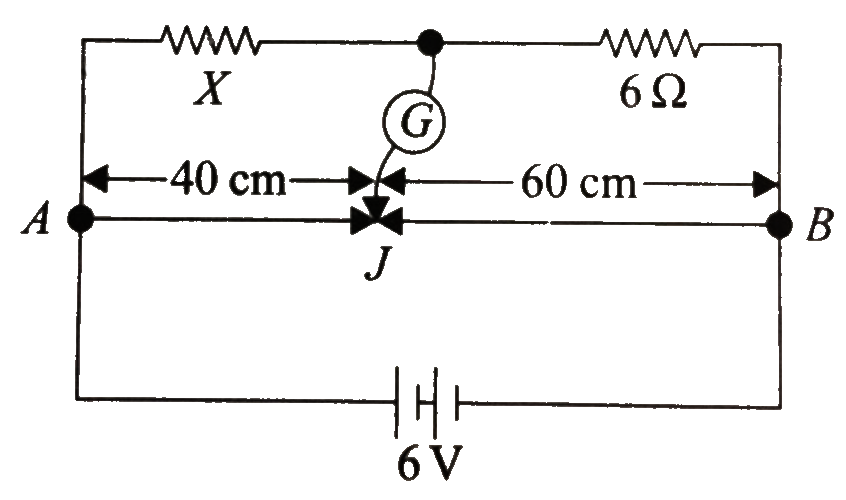In the above question, what would have been the change in current in A if battery were some internal resistance.
no change
decreases
increases
cannot say
The correct Answer is:B
To find the change in current in circuit A when a battery with internal resistance is introduced, we can follow these steps:
1. Understand the Circuit: Initially, we have a circuit powered by a battery with an electromotive force (EMF) E and no internal resistance. The current flowing through the circuit is given by Ohm's Law.
2. Introduce Internal Resistance: When we introduce an internal resistance R1 in the battery, the effective voltage across the external circuit will change. The terminal voltage V of the battery can be expressed as:
V=E−IR1
where I is the current flowing through the circuit.
3. Determine the Total Resistance: If there are additional resistors in the circuit, we need to consider the total resistance R of the external circuit. If the resistors are in series, the total resistance remains R. If they are in parallel, we need to calculate the equivalent resistance.
4. Calculate the New Current: The new current I′ flowing through the circuit with the internal resistance can be calculated using Ohm's Law:
I′=VR=E−IR1R
Here, I represents the current before the internal resistance was introduced.
5. Compare the Currents: In the original case without internal resistance, the current was:
I=ER
Now, with the internal resistance, we have:
I′=E−IR1R
Since E−IR1<E, it is evident that I′<I.
6. Conclusion: The introduction of internal resistance in the battery leads to a decrease in the current flowing through the circuit.
Final Answer:
The current in circuit A decreases when the battery has some internal resistance.
---
V=E−IR1
where I is the current flowing through the circuit.
I′=VR=E−IR1R
Here, I represents the current before the internal resistance was introduced.
I=ER
Now, with the internal resistance, we have:
I′=E−IR1R
Since E−IR1<E, it is evident that I′<I.
The current in circuit A decreases when the battery has some internal resistance.
Topper's Solved these Questions
- ELECTRIC CURRENT AND CIRCUITBOOK - CENGAGE PHYSICS ENGLISHCHAPTER - ELECTRIC CURRENT AND CIRCUITEXERCISE - Multiple Correct
16 Videos
- ELECTRIC CURRENT AND CIRCUITBOOK - CENGAGE PHYSICS ENGLISHCHAPTER - ELECTRIC CURRENT AND CIRCUITEXERCISE - Comprehension
35 Videos
- ELECTRIC CURRENT AND CIRCUITBOOK - CENGAGE PHYSICS ENGLISHCHAPTER - ELECTRIC CURRENT AND CIRCUITEXERCISE - Subjective
29 Videos
- ELECTRIC CURRENT & CIRCUITSBOOK - CENGAGE PHYSICS ENGLISHCHAPTER - ELECTRIC CURRENT & CIRCUITSEXERCISE - Kirchhoff s law and simple circuits
15 Videos
- ELECTRIC FLUX AND GAUSS LAWBOOK - CENGAGE PHYSICS ENGLISHCHAPTER - ELECTRIC FLUX AND GAUSS LAWEXERCISE - MCQ s
38 Videos
Similar Questions
In the gives circuit, a meter bridge is shows in a balanced state. The bridge wire has a resistance of 1Ωcm−1. Find the value of the unknown resistance X and the current draws from the battery of negligible internal resistance.

View SolutionStatement I: Internal resistance of a battery is drawn parallel to a battery in electical circuit.
Statement II: Heat generated in a battery is due to internal resistance.
View SolutionA 50 V battery is supplying current of 10 A when connected to a resistor. If the efficiency of the battery at this current is 25%, then the internal resistance of the battery is
View SolutionA battery of e.m.f 3 V supplies current through a circuit in which the resistance can be changed. A high resistance voltmeter is connected across the battery. When the current is 1.5 A, the voltmeter reads 2.7 V. Find the internal resistance of the battery.
View SolutionA car has a fresh storage battery of emt 12V and internal resistance 5.0×10−2Ω. If the starter moter draws a current of 90A, what is the terminal voltage of the battery when the starter is on?
(b) After long use, the internal resistance of the storange battery increase to 500Ω. What maximum current can be drawn from the battery? Assume the emt of the battery to remain unchanged.
(c) If the discharged battery is changed by an external emf source, is the terminal voltage of the battery during changing greater of less than is emf 12V?
View SolutionFour equal resistance dissipated 5 W of power together when connected in series to a battery of negligible internal resistance . The total power dissipated in these resistance when connected in parallel across the same battery would be .
View SolutionA 50V battery is connected across a 10 ohm resistor. The current is 4.5A is flowing through the resistor then the internal resistance of the battery is
View SolutionWhat is the change in velocity in the above question?
View SolutionFirst a set of n equal resistors of R each are connected in series to a battery of emf E and internal resistance R. A current I is observed to flow. Then, the n resistors are connected in parallel to the same battery. It is observed that the current is increased 10 times. What is 'n'?
View SolutionWould the charge change if the plates were pulled without battery ?
View Solution
